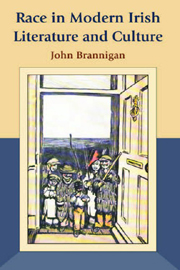Book contents
- Frontmatter
- Contents
- Illustrations
- Acknowledgements
- Introduction
- 1 1922, Ulysses, and the Irish Race Congress
- 2 Face Value: Racial Typology and Irish Modernism
- 3 ‘Aliens in Ireland’: Nation-building and the Ethics of Hospitality
- 4 ‘Ireland, and Black!’: The Cultural Politics of Racial Figuration
- Conclusion: Imagining the ‘New Hibernia’
- Bibliography
- Index
1 - 1922, Ulysses, and the Irish Race Congress
Published online by Cambridge University Press: 12 September 2012
- Frontmatter
- Contents
- Illustrations
- Acknowledgements
- Introduction
- 1 1922, Ulysses, and the Irish Race Congress
- 2 Face Value: Racial Typology and Irish Modernism
- 3 ‘Aliens in Ireland’: Nation-building and the Ethics of Hospitality
- 4 ‘Ireland, and Black!’: The Cultural Politics of Racial Figuration
- Conclusion: Imagining the ‘New Hibernia’
- Bibliography
- Index
Summary
The advertisement for Golden Blush cigarettes which took up the front page of the Irish Independent on 4 January 1922 offers a revealing graphic narrative of Ireland's passage into industrialised modernity. In contrast to the well-worn themes of colonial oppression, mass emigration, and economic underdevelopment, the sequential illustrations bring us from the raw materials in plantation fields in Virginia, controlled by the Irish manufacturers, through to the cathedral-like cigarette factory in Dublin, and on to the happy male consumers who symbolise an Irish public, mature and contented with its own modernity. Embroidered with a Celtic interlace design, the illustrations are thus branded with allegiance to the cultural nationalism of the revival period, and announce the arrival of a specifically Irish industrial modernity. In doing so, it proffers a political vision more optimistic than was possible for the provisional government ushered into place just three days later, on 7 January 1922, when the Dáil ratified the Anglo-Irish treaty, and thus paved the way for the establishment of the Irish Free State later that year. The advertisement envisions industrial development, profitable on the back of cheap foreign raw materials, and skilled employment in manufacturing, distribution, and sales in a city characterised by social harmony, prosperity, and a thriving consumer culture. That this story of national triumph is concerned with tobacco, a product with historic associations with colonial and capitalist exploitation of black labour, is itself significant and revealing of the ideological complexities of this marriage of counter-colonial nationalism and industrial modernity.
- Type
- Chapter
- Information
- Race in Modern Irish Literature and Culture , pp. 16 - 77Publisher: Edinburgh University PressPrint publication year: 2009

